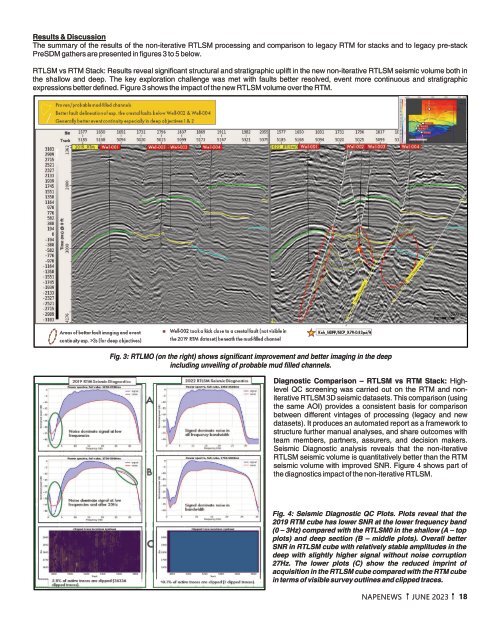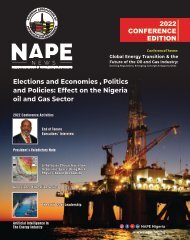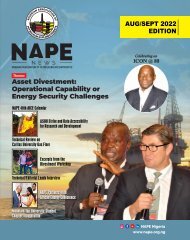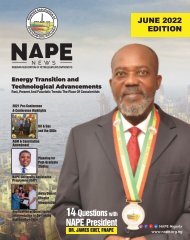NAPENews Magazine June 2023 Edition
NAPENews Magazine June 2023 Edition
NAPENews Magazine June 2023 Edition
Create successful ePaper yourself
Turn your PDF publications into a flip-book with our unique Google optimized e-Paper software.
Results & Discussion<br />
The summary of the results of the non-iterative RTLSM processing and comparison to legacy RTM for stacks and to legacy pre-stack<br />
PreSDM gathers are presented in figures 3 to 5 below.<br />
RTLSM vs RTM Stack: Results reveal significant structural and stratigraphic uplift in the new non-iterative RTLSM seismic volume both in<br />
the shallow and deep. The key exploration challenge was met with faults better resolved, event more continuous and stratigraphic<br />
expressions better defined. Figure 3 shows the impact of the new RTLSM volume over the RTM.<br />
Fig. 3: RTLMO (on the right) shows significant improvement and better imaging in the deep<br />
including unveiling of probable mud filled channels.<br />
Diagnostic Comparison – RTLSM vs RTM Stack: Highlevel<br />
QC screening was carried out on the RTM and noniterative<br />
RTLSM 3D seismic datasets. This comparison (using<br />
the same AOI) provides a consistent basis for comparison<br />
between different vintages of processing (legacy and new<br />
datasets). It produces an automated report as a framework to<br />
structure further manual analyses, and share outcomes with<br />
team members, partners, assurers, and decision makers.<br />
Seismic Diagnostic analysis reveals that the non-iterative<br />
RTLSM seismic volume is quantitatively better than the RTM<br />
seismic volume with improved SNR. Figure 4 shows part of<br />
the diagnostics impact of the non-iterative RTLSM.<br />
Fig. 4: Seismic Diagnostic QC Plots. Plots reveal that the<br />
2019 RTM cube has lower SNR at the lower frequency band<br />
(0 – 3Hz) compared with the RTLSM0 in the shallow (A – top<br />
plots) and deep section (B – middle plots). Overall better<br />
SNR in RTLSM cube with relatively stable amplitudes in the<br />
deep with slightly higher signal without noise corruption<br />
27Hz. The lower plots (C) show the reduced imprint of<br />
acquisition in the RTLSM cube compared with the RTM cube<br />
in terms of visible survey outlines and clipped traces.<br />
NAPENEWS JUNE <strong>2023</strong> 18










